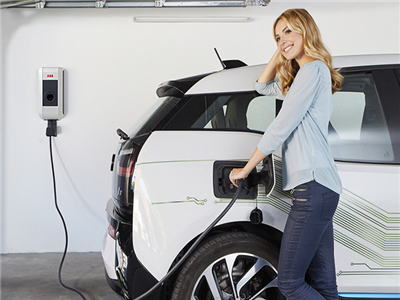Install an EV charging station
Having the option of charging your electric car at home is crucial to ensuring that you’re fueled up and ready to go whenever you need it. There are three types of electric car charging stations. Each has their own installation process.
Installing a Level 1 electric vehicle charger
Level 1 EV chargers come with your electric vehicle and don’t require any special installation – simply plug your Level 1 charger into a standard 120 volt wall outlet and you’re ready to go. This is the biggest appeal of a Level 1 charging system: you don’t have to deal with any extra costs associated with an installation, and you can set the entire charging system up without a professional.
Installing a Level 2 electric vehicle charger
A level 2 EV charger uses 240 volts of electricity. This has the benefit of offering faster charging time, but it requires a special installation procedure as a standard wall outlet only provides 120 volts. Appliances like electric dryers or ovens use 240 volts as well, and the installation process is very similar.
Level 2 EV charger: the specifics
Level 2 installation requires running 240 volts from your breaker panel to your charging location. A “double-pole” circuit breaker needs to be attached to two 120 volt buses at once to double the circuit voltage to 240 volts, using a 4-strand cable. From a wiring perspective, this involves attaching a ground wire to the ground bus bar, a common wire to the wire bus bar, and two hot wires to the double-pole breaker. You may have to replace your breaker box entirely to have a compatible interface, or you may be able to simply install a double-pole breaker in your existing panel. It is essential to make sure that you shut off all power going into your breaker box by shutting off all breakers, followed by shutting off your main breaker.
Once you have the correct circuit breaker attached to your home wiring, you can run your newly installed 4-strand cable to your charging location. This 4-strand cable needs to be properly insulated and secured to prevent from damage to your electrical systems, especially if it is being installed outdoors at any point. The last step is to mount your charging unit where you will be charging your vehicle, and attach it to the 240 volt cable. The charging unit acts as a safe holding location for the charge current, and doesn’t let electricity flow through until it senses that your charger is connected to your car’s charging port.
Considering the technical nature and risk of a Level 2 EV charger DIY installation, it is always smart to hire a professional electrician to install your charging station. Local building codes often require permits and inspections by a professional anyways, and making an error with an electrical installation can cause cause material damage to your home and electrical systems. Electric work is also a health hazard, and it is always safer to let an experienced professional handle electric work.
Install an EV charger with your solar panel system
Pairing your EV with rooftop solar is a great combined energy solution. Sometimes solar installers will even offer package purchase options involving a full EV charger installation with your solar installation. If you’re considering upgrading to an electric car sometime in the future, but want to go solar now, there are a few considerations that will make the process easier. For example, you can invest in microinverters for your PV system so that if your energy needs increase when you buy your EV, you can easily add extra panels after the initial install.
Installing a Level 3 electric vehicle charger
Level 3 charging stations, or DC Fast Chargers, are primarily used in commercial and industrial settings, as they are usually prohibitively expensive and require specialized and powerful equipment to operate. This means that DC Fast Chargers are not available for home installation.
Most Level 3 chargers will provide compatible vehicles with about 80 percent charge in 30 minutes, which makes them better suited for roadside charging stations. For Tesla Model S owners, the option of “supercharging” is available. Tesla’s Superchargers are capable of putting about 170 miles worth of range into the Model S in 30 minutes. An important note about level 3 chargers is that not all chargers are compatible with all vehicles. Make sure you understand which public charging stations can be used with your electric vehicle before relying on level 3 chargers for recharging on the road.
The cost for charging at a public EV charging station is also diverse. Depending on your provider, your charging rates may be highly variable. EV charging station fees can be structured as flat monthly fees, per-minute fees, or a combination of both. Research your local public charging plans to find one that fits your car and needs best.
Post time: May-03-2021







